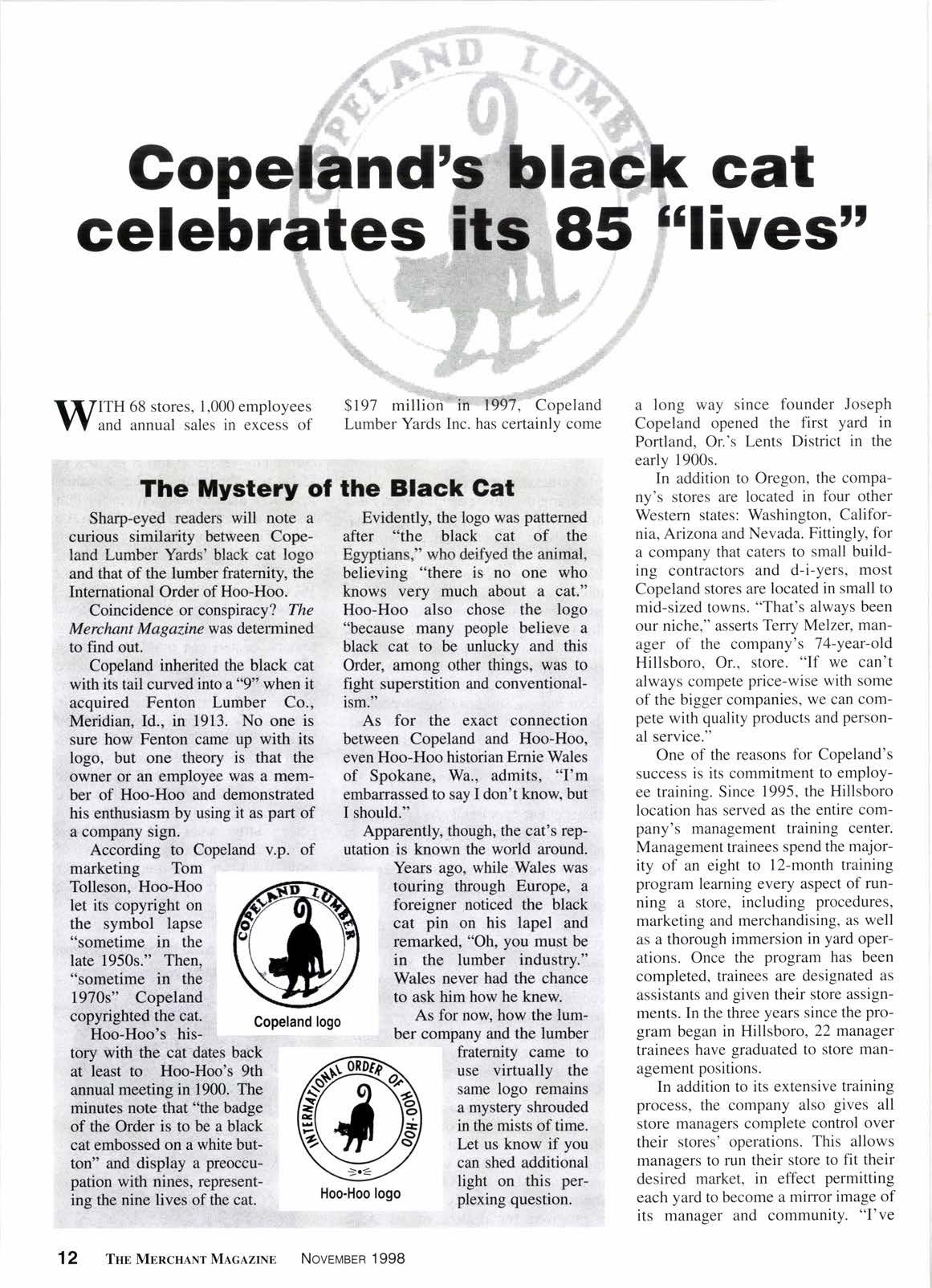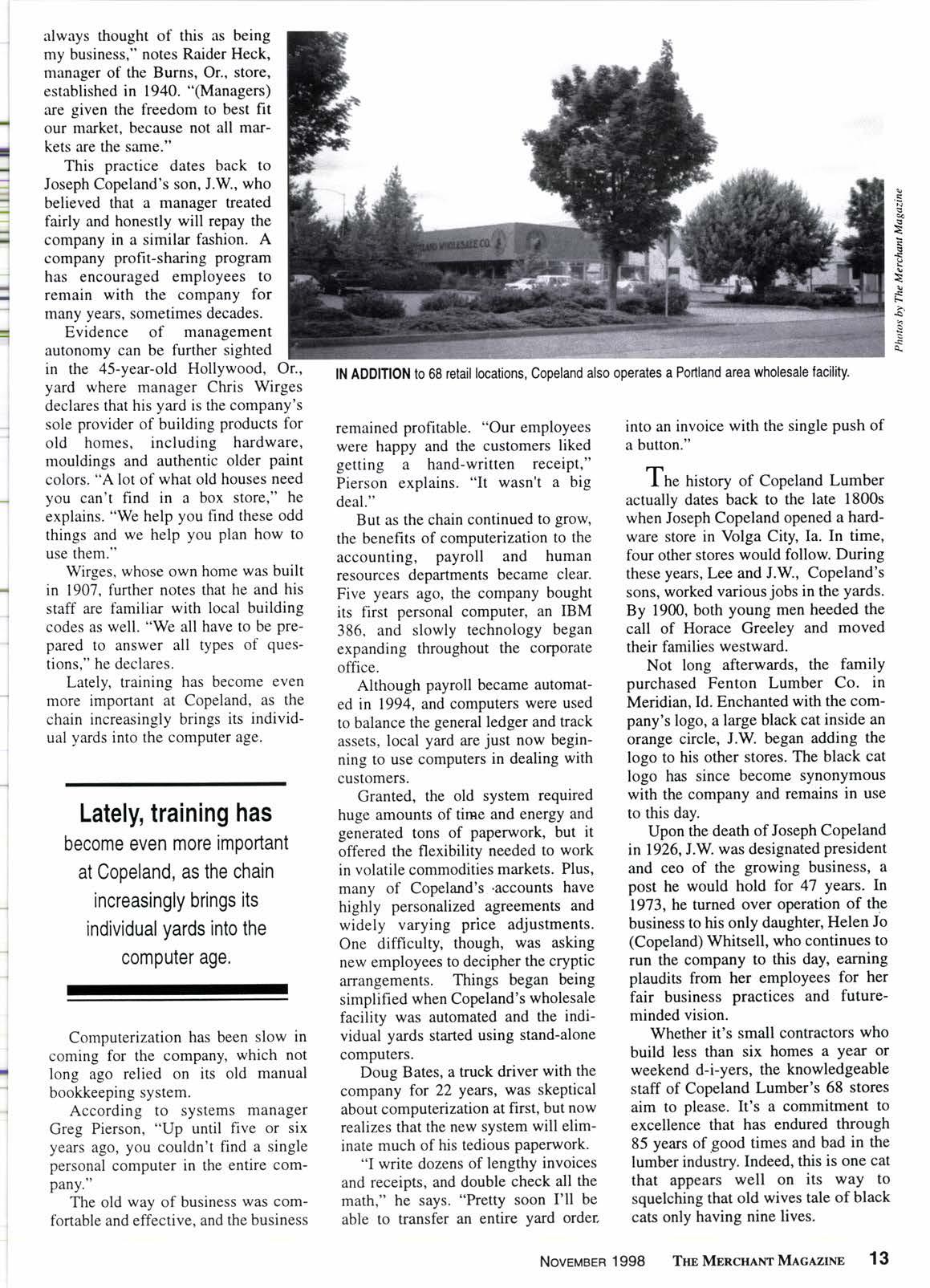
5 minute read
Gop ndt la cat tes 85 tlivestt celebr
ITH 68 stores, 1,000 employees and annual sales in excess of Lumber Yards Inc. has certainly come
Of Ihe
, the logo was patterned black cat of the
Egypti,urs," who deifyd,rhe a$*ffi{i beliiving "there is no one who knows very much about a cat." Hoo-Hoo also chose the 'logo "because many people believe a black cat to be unlucky and this Order, among other things, was to fight superstition and co,nventionalisttl."
As for the exact connection be.tw€cn Copeland and Hoo.lloo,,:, evpn Hoo-Hoo historian Ernie Wales of Spokane, Wa., admits, "I'm embarassed to say I don't know, but I should."
v.p. of
Apparently, thougtr, the cat's rep utation is known the world around Years ago, while Wales was touring through Europe, a foreigner noticed the black "at pin on his lapel and remarked" "Oh. you mrrst be in the lumber industry." .:.'.Wales never had:the cGirce ' to ask him how he knew.
As for now, how the lumber company and the lumber fratemity came to use virtually the sarne logo remains a my$tery s$w6"6 in ttm mists of time. Let us know if you can.shed additional light on this perplexing queefion.
a long way since founder Joseph Copeland opened the first yard in Portland, Or.'s Lents District in the early 1900s.
In addition to Oregon, the company's stores are located in four other Western states: Washington, California, Arizona and Nevada. Fittingly, for a company that caters to small building contractors and d-i-yers, most Copeland stores are located in small to mid-sized towns. "That's always been our niche," asserts Terry Melzer, manager of the company's 74-year-old Hillsboro. Or.. store. "If we can't always compete price-wise with some of the bigger companies, we can compete with quality products and personal service."
One of the reasons for Copeland's success is its commitment to employee training. Since 1995, the Hillsboro location has served as the entire company's management training center. Management trainees spend the majority of an eight to l2-month training program learning every aspect of running a store, including procedures, marketing and merchandising, as well as a thorough immersion in yard operations. Once the program has been completed, trainees are designated as assistants and given their store assignments. In the three years since the program began in Hillsboro, 22 manager trainees have graduated to store management positions.
In addition to its extensive training process, the company also gives all store managers complete control over their stores' operations. This allows managers to run their store to fit their desired market, in effect permitting each yard to become a mirror image of its manager and community. "I've always thought of this as being my business," notes Raider Heck, manager of the Burns, Or., store, established in 1940. "(Managers) are given the freedom to best fit our market, because not all markets are the same." remained profitable. "Our employees were happy and the customers liked getting a hand-written receipt," Pierson explains. "It wasn't a big deal."
This practice dates back to Joseph Copeland's son, J.W., who believed that a manager treated fairly and honestly will repay the company in a similar fashion. A company proht-sharing program has encouraged employees to remain with the company for many years, sometimes decades.
Evidence of management autonomy can be further sighted in the 45-year-old Hollywood, Or., yard where manager Chris Wirges declares that his yard is the company's sole provider of building products for old homes, including hardware, mouldings and authentic older paint colors. "A lot of what old houses need you can't find in a box store," he explains. "We help you find these odd things and we help you plan how to use them."
Wirges, whose own home was built in 1907, further notes that he and his staff are familiar with local building codes as well. "We all have to be prepared to answer all types of questions," he declares.
Lately, training has become even more important at Copeland, as the chain increasingly brings its individual yards into the computer age.
But as the chain continued to grow, the benefits of computerization to the accounting, payroll and human resources departments became clear. Five years ago, the company bought its first personal computer, an IBM 386, and slowly technology began expanding throughout the corporate office.
Although payroll became automated in 1994, and computers were used to balance the general ledger and track assets, local yard are just now beginning to use computers in dealing with customers, into an invoice with the single push of a button." rTl
I he history of Copeland Lumber actually dates back to the late 1800s when Joseph Copeland opened a hardware store in Volga City, Ia. In time, four other stores would follow. During these years, Lee and J.W., Copeland's sons, worked variousjobs in the yards. By 1900, both young men heeded the call of Horace Greeley and moved their families westward.
Lately, has become even more impoftant at Copeland, as the chain increasingly brings its individual yards into the computer age.
Computerization has been slow in coming for the company, which not long ago relied on is old manual bookkeeping system.
According to systems manager Greg Pierson, "Up until five or six years ago, you couldn't find a single personal computer in the entire company."
The old way of business was comfortable and effective, and the business
Granted, the old system required huge amounts of tirne and energy and generated tons of paperwork, but it offered the flexibility needed to work in volatile commodities markets. Plus, many of Copeland's .accounts have highly personalized agreements and widely varying price adjustments. One difflculty, though, was asking new employees to decipher the cryptic arrangements. Things began being simplifi ed when Copeland's wholesale facility was automated and the individual yards started using stand-alone computers.
Doug Bates, a truck driver with the company for 22 years, was skeptical about computerization at first, but now realizes that the new system will eliminate much of his tedious paperwork.
"I write dozens of lengthy invoices and receipts, and double check all the math," he says. "Pretty soon I'll be able to transfer an entire yard order
Not long afterwards, the familY purchased Fenton Lumber Co. in Meridian,Id. Enchanted with the company's logo, a large black cat inside an orange circle, J.W. began adding the logo to his other stores. The black cat logo has since become synonymous with the company and remains in use to this day.

Upon the death of Joseph Copeland in 1926, J.W. was designated president and ceo of the growing business, a post he would hold for 47 years. In 1973,he turned over operation of the business to his only daughter, Helen Jo (Copeland) Whitsell, who continues to run the company to this day, earning plaudits from her employees for her fair business practices and futureminded vision.
Whether it's small contractors who build less than six homes a Year or weekend d-i-yers, the knowledgeable staff of Copeland Lumber's 68 stores aim to please. It's a commitrnent to excellence that has endured through 85 years of good times and bad in the lumber industry. Indeed, this is one cat that appears well on its waY to squelching that old wives tale of black cats only having nine lives.










